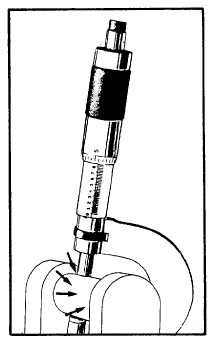to avoid distorting them, and tapping the cap lightly on one side and then the other.
CRANKSHAFT REMOVAL
Once the bearing caps have been removed, lift the crankshaft out of the engine block. Usually one or two people do this seemingly simple operation by hand. With larger crankshafts, use a hoist (fig. 3-25), lifting above the center with a rope sling around two of the throws.
CAUTION
Do not bang the crankshaft around causing damage that will have to be repaired before the crankshaft may be put back in service.
CRANKSHAFT JOURNAL CHECK
The preferred method of measuring crank- shaft journals is as follows. Remove the crankshaft from the engine block and clean the surfaces to be measured. Using the appropriate outside micrometer, measure the journals at several points around and across the bearing surface (fig. 3-26). Measurements around the journal will show if the journal is out of round. Those measurements across the surface show if the journal is tapered. Journals that are

Figure 3-25. - Crankshaft removal using hoist.

Figure 3-26. - Measuring the journals at different points around the diameter and along the length of the bearing surface.
tapered or out of round more than .003 must be reground. BE SURE THAT YOU ALWAYS REFER TO MANUFACTURER'S SPECIFICATIONS WHEN PERFORMING ANY CRANK- SHAFT WORK.
CHECKING OF BEARING FIT
You should always check bearing fit or oil clearance when installing new bearings. When the bearing caps are off, you should measure the journals so that you can detect wear, out of roundness, or taper.
You can check bearing clearance with either feeler stock or Plastigage. Plastigage is a plastic material that is flattened by pressure. The amount it flattens indicates the amount of clearance.
Before checking bearing clearance with Plasti- gage, wipe the journal and the bearing clean of oil. Then place a strip of the Plastigage lengthwise in the center of the bearing cap (fig. 3-26). Install the cap next and tighten it into place. When the cap is removed, you can measure the amount of flattening of the strip with a special scale (fig. 3-26). Do NOT remove the flattened strip from the cap or the journal to measure the width, but
Continue Reading